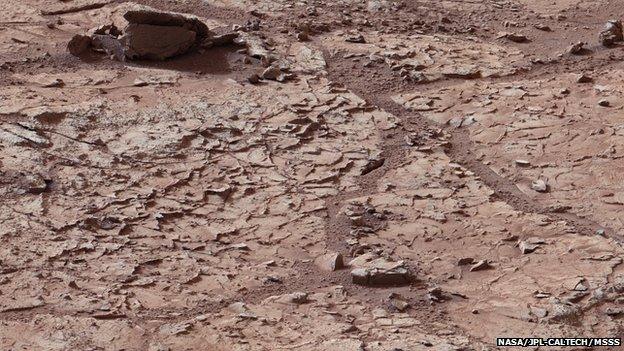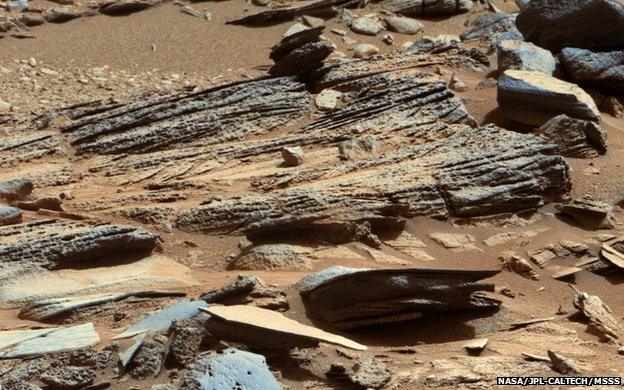Curiosity Mars rover eyes rock drill site
- Published

This mosaic, built from images acquired last week, looks along the edge of Yellowknife Bay towards the proposed drill site. The vista was assembled by Ken Kremer and Marco Di Lorenzo using photos from the rover's black and white navigation cameras. The final picture has then been coloured
The US space agency (Nasa) says it is now ready for its Curiosity rover to start drilling on Mars.
A target patch of ground has been chosen in an area that contains a diverse range of rocks, many of which were clearly deposited in water.
Richard Cook, the rover project manager, said the team still needed to identify the exact spot for drilling.
This would become apparent after an assessment was made using the robot's survey instruments, he explained.
"Probably within two weeks is when we'll start our first drill holes," he told the BBC.
And he cautioned that it would be a slow process, not least because the drill mechanism needs to be cleaned of any contaminants that might have journeyed to Mars from Earth.
This means taking and dumping several cores before finally delivering a smaller than aspirin-sized pinch of powdered rock to Curiosity's two big onboard analysis labs.
The mission team has named the prospective drill site after a former rover engineer, John Klein, who died in 2011.
Curiosity, which has now spent five months on the Red Planet, is trying to determine whether past environments in the deep crater where it landed might have allowed microbial life to flourish.
Already it has identified rock deposits that were laid down in a streambed billions of years ago.
These sediments, which were seen just weeks after the 6 August touch-down, contained pebbles that had been rounded in the erosive process of being carried in water.
Curiosity has also identified some sharply inclined layers of finer-grained material that again hint at deposition in a stream.

The area chosen for drilling has been named "John Klein", after a rover engineer who died in 2011
Both of these rock forms were on higher ground to where Curiosity finds itself today. Currently, the rover is sitting in a small depression known as Yellowknife Bay.
This region of lower ground contains older sediments, but ones that still reflect conditions where a lot of water must have been present at some point.
Among these rocks is the candidate drill site, John Klein. This outcrop contains yet finer grains but it is cut through with veins that the rover's ChemCam laser spectrometer indicates hold precipitated minerals - most likely hydrated calcium sulphate, possibly bassinite or gypsum.
"On Earth, usually, these veins are formed by water circulation in fractures, and this usually occurs in low to moderate temperatures," said ChemCam team member Nicolas Mangold of the Laboratoire de Planetologie et Geodynamique de Nantes, France.
Apparent, also, are lots of small spherules, or concretions, which again are strongly indicative of mineral precipitation in water.
Curiosity project scientist John Grotzinger told reporters that the rover had hit the "jackpot".
He said the drilling operations would attempt in the coming weeks to acquire samples from the veins and the concretions for study in the robot's CheMin and Sam labs.
"The main goal is to try to assess this material in a very general way that will give us an appraisal of the habitability of this environment," he explained.
Following the water on Mars has long been a strategy to try to understand the planet's past potential for life. Everything we know about biology tells us that water is essential prerequisite.

Rover "jackpot": Curiosity landed in a crater where water has shaped many of the rocks

The veins that cut through the rock are most likely a hydrated calcium sulphate
You can see more Curiosity mosaics by Ken Kremer and Marco Di Lorenzo at Ken's website, external.
Jonathan.Amos-INTERNET@bbc.co.uk and follow me on Twitter:
- Published8 January 2013
- Published4 January 2013
- Published3 January 2013
- Published4 December 2012
- Published4 December 2012
- Published10 September 2012
- Published6 August 2012
- Published25 May 2012